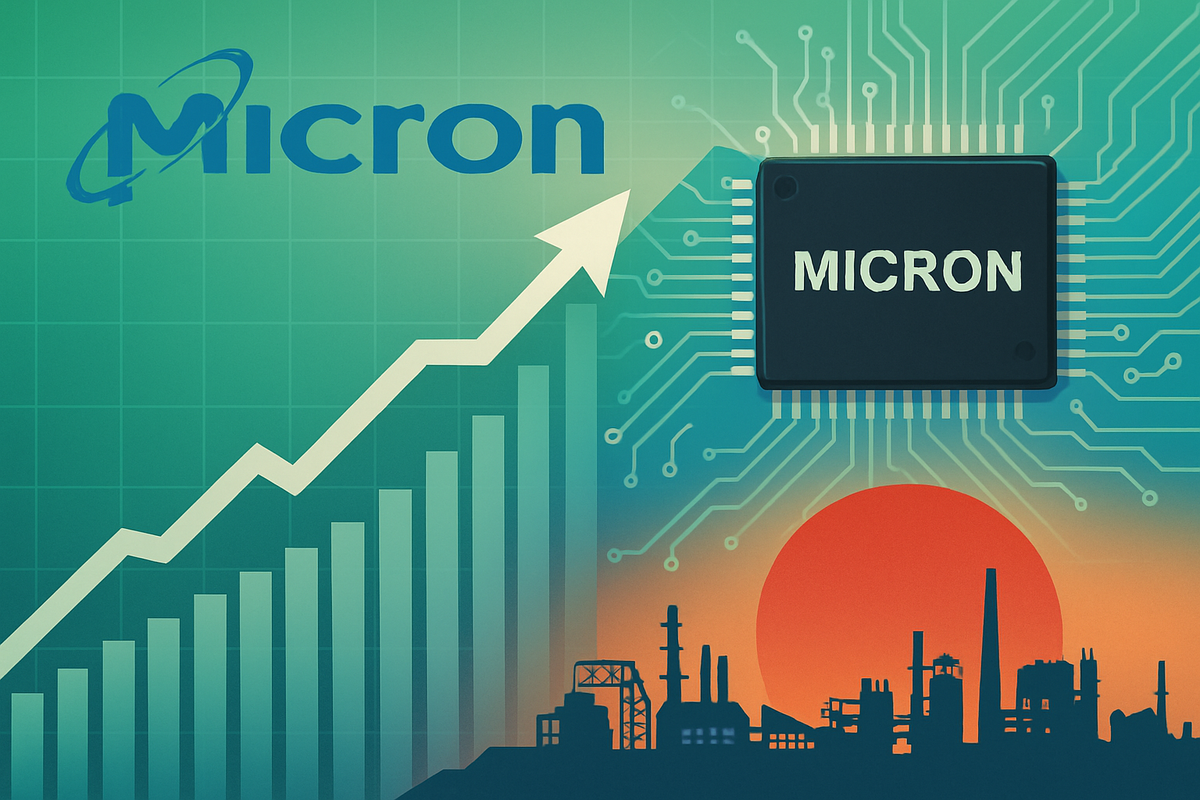
Tokyo, Japan – October 6, 2025 – Micron Technology (NASDAQ: MU) is currently experiencing a monumental surge, with its stock reaching unprecedented fresh highs, propelled by robust demand for memory chips, particularly from the burgeoning artificial intelligence (AI) sector. This impressive market performance coincides with the company's significant commitment of up to $3.6 billion (approximately 500 billion yen) towards a strategic investment in Japan, aimed at advancing next-generation semiconductor manufacturing. The dual momentum of a soaring stock valuation and a substantial global expansion underscores Micron's pivotal role in the evolving technological landscape and its aggressive pursuit of leadership in advanced memory solutions.
The confluence of a strong market rally and a major international investment highlights Micron's strategic positioning. The company's stock gains reflect investor confidence in its technological advancements, especially in High-Bandwidth Memory (HBM), which is critical for AI applications. Simultaneously, the Japanese investment signals a clear intent to fortify its global manufacturing footprint, introduce cutting-edge Extreme Ultraviolet (EUV) technology to Japan, and secure a leading edge in the production of 1-gamma process technology DRAM chips, essential for the future of generative AI. This move is poised to have profound implications for the global semiconductor supply chain and the competitive dynamics within the memory market.
Micron's Unprecedented Rally and Landmark Japanese Investment Unpacked
Micron Technology's stock has been on an extraordinary trajectory, establishing a new 52-week high by October 6, 2025, with shares trading between $194.55 and $199.22. The company has enjoyed a remarkable six-day continuous streak of gains, culminating in a cumulative 20% return by October 4, 2025. Year-to-date in 2025, Micron's stock has soared by an astonishing 123% to 131.31%, with a 43% to 50.86% increase over the past month alone. This rally is largely fueled by Micron's strategic dominance in AI-driven memory and storage markets, particularly its High-Bandwidth Memory (HBM) business, which is reportedly generating nearly $2 billion per quarter and is fully sold out through 2026, with HBM4 pre-selling already underway.
Analyst sentiment has mirrored this optimism, with Morgan Stanley upgrading Micron's stock to "Overweight" from "Equal Weight" on October 6, 2025, and significantly raising its price target to $220 from $160. The upgrade cites expectations of multiple quarters of double-digit price increases for Micron's core DRAM products, driven by robust demand from server and storage markets, which is anticipated to lead to supply tightness for DRAM and NAND through 2026. The company's strong fiscal Q3 2025 earnings, reporting $9.3 billion in revenue and $1.91 EPS, exceeded analyst expectations, further solidifying investor confidence. Fiscal Q4 2025 revenue reached $11.3 billion, marking a substantial 46% year-over-year growth.
Parallel to its market triumph, Micron is making a substantial investment of up to 500 billion yen (approximately $3.6 billion to $3.7 billion USD) in Japan. This investment is specifically targeted at its Hiroshima plant for research and development and capital expenditures, focusing on advancing the production of next-generation 1-gamma process technology DRAM chips, crucial for generative AI applications. A groundbreaking aspect of this initiative is Micron's commitment to introduce Extreme Ultraviolet (EUV) technology to Japan for production, marking it as the first semiconductor company to do so. The Japanese government is providing significant support, including subsidies amounting to $3.63 billion for the Hiroshima plant, with an increased $1.29 billion specifically for EUV adoption, aiming for mass production of advanced memory chips by 2028. This strategic partnership aligns with Japan's broader goal of bolstering its domestic semiconductor industry and becoming a key player in the global supply chain for cutting-edge memory technology.
Market Dynamics: Winners and Losers in the Semiconductor Arena
Micron's aggressive expansion and technological advancements are poised to reshape the competitive landscape of the global semiconductor industry, creating clear winners and potential challenges for various stakeholders. On the winning side, Micron Technology (NASDAQ: MU) itself stands to gain significantly. Its investment in 1-gamma DRAM and EUV technology in Japan will solidify its position at the forefront of memory chip innovation, particularly in the high-growth AI segment. This strategic move is expected to enhance its market share, improve profitability through advanced manufacturing efficiencies, and further diversify its supply chain away from potential geopolitical risks concentrated in other regions.
The Japanese semiconductor ecosystem is another major beneficiary. The substantial government subsidies and Micron's commitment to bring EUV technology to its Hiroshima plant will inject significant capital and advanced expertise into the local industry. This will likely create numerous high-skilled jobs, foster a stronger talent pool, and attract further investment in related fields. Local suppliers of materials, equipment, and services for semiconductor manufacturing, such as Tokyo Electron (TYO: 8035), a leading producer of semiconductor manufacturing equipment, could see increased demand for their products and services. The investment also aligns with Japan's broader industrial policy to revitalize its domestic chip production capabilities and enhance national economic security.
Conversely, Micron's direct competitors in the DRAM and NAND flash markets, primarily Samsung Electronics (KRX: 005930) and SK Hynix (KRX: 000660), might face intensified competition. While these companies are also heavily invested in advanced memory technologies and AI-driven solutions, Micron's strategic move into EUV in Japan could provide it with a distinct advantage in terms of production efficiency, cost structure, and technological leadership in certain segments. This could pressure competitors to accelerate their own R&D and manufacturing investments to keep pace, potentially leading to increased capital expenditure and tighter margins in the short term across the industry. Furthermore, any companies heavily reliant on older memory technologies or less efficient manufacturing processes may find it increasingly difficult to compete with Micron's advanced offerings, potentially leading to a loss of market share and profitability.
Broader Significance: Reshaping the Global Semiconductor Landscape
Micron's strategic investment in Japan and its surging stock performance are not isolated events but rather integral components of a much wider trend reshaping the global semiconductor industry. This event fits squarely into the broader movement towards diversifying and strengthening semiconductor supply chains, a critical imperative in the wake of recent geopolitical tensions and pandemic-induced disruptions. Nations, including Japan and the United States, are actively pursuing policies and offering substantial incentives to bring advanced manufacturing capabilities onshore or to allied nations, reducing reliance on a few concentrated production hubs. Micron's decision to introduce cutting-edge EUV technology to Japan directly supports this goal, positioning Japan as a more robust and self-reliant player in the advanced memory sector.
The potential ripple effects on competitors and partners are significant. For partners, particularly those in the AI and data center segments, a more diversified and technologically advanced supply of memory chips from Micron could mean greater stability, improved performance, and potentially more competitive pricing. For competitors like Samsung (KRX: 005930) and SK Hynix (KRX: 000660), this move by Micron intensifies the arms race in memory chip innovation and manufacturing. It could compel them to accelerate their own investments in next-generation technologies and explore similar regional diversification strategies to maintain their competitive edge. The increased competition in advanced DRAM production, particularly for AI applications, will likely drive further innovation across the industry.
Regulatory and policy implications are also profound. The substantial subsidies provided by the Japanese government underscore a global trend of state intervention to foster critical technology industries. This could set a precedent for other nations to offer even more attractive incentives, leading to a potential subsidy race as countries vie for advanced manufacturing facilities. Historically, governments have supported strategic industries, but the current scale of semiconductor subsidies reflects a new level of urgency driven by national security and economic competitiveness concerns. This event echoes past efforts by nations to build domestic semiconductor capabilities, but with the added complexity of hyper-globalized supply chains and rapidly advancing technology like EUV. The collaboration between Micron and the Japanese government serves as a model for public-private partnerships aimed at securing technological leadership in the 21st century.
The Road Ahead: Navigating Future Opportunities and Challenges
Looking ahead, Micron's aggressive strategic moves set the stage for both significant opportunities and potential challenges. In the short term, the company is poised to capitalize on the insatiable demand for High-Bandwidth Memory (HBM) and other advanced DRAM products, fueled by the accelerating adoption of AI across various industries. The Japan investment, with its focus on 1-gamma DRAM and EUV technology, positions Micron to capture a substantial share of the next wave of memory demand, particularly for high-performance computing and generative AI applications. This could translate into continued revenue growth and enhanced profitability, especially if memory prices remain strong as projected by analysts.
In the long term, Micron's strategic pivot towards regional diversification and technological leadership through EUV adoption in Japan could significantly de-risk its supply chain and strengthen its global competitive standing. This move allows for greater resilience against geopolitical disruptions and positions the company to better serve diverse global markets. Potential strategic pivots for Micron might include further investments in other key regions, deeper collaborations with AI hardware developers, and an intensified focus on optimizing its manufacturing processes to maximize the returns from its advanced technology investments. The market opportunities that may emerge include expanding into new AI-driven verticals, developing specialized memory solutions for emerging technologies like quantum computing, and consolidating its leadership in enterprise and data center solutions.
However, the path forward is not without potential pitfalls. The significant capital expenditure required for advanced manufacturing, as highlighted by the Japan investment, could put pressure on Micron's balance sheet if market demand softens or if there's an unexpected downturn in the semiconductor cycle. The global semiconductor market is notoriously cyclical, and while current forecasts are optimistic, an oversupply scenario in the future could impact pricing and profitability. Geopolitical tensions, despite diversification efforts, could still pose risks to global trade and supply chains. Furthermore, the intense competition from rivals like Samsung (KRX: 005930) and SK Hynix (KRX: 000660) means Micron must continuously innovate and execute flawlessly to maintain its technological edge. Potential scenarios include a sustained period of high growth driven by AI, a more moderate expansion with occasional market corrections, or, in a less likely but possible scenario, a significant market slowdown if global economic conditions deteriorate. Micron's ability to adapt its production, manage costs, and continue innovating will be crucial in navigating these future landscapes.
Comprehensive Wrap-up: A New Era for Micron and the Memory Market
Micron Technology's recent achievements—a soaring stock price reaching fresh highs and a monumental $3.6 billion investment in Japan—mark a definitive turning point for the company and signal a new era for the global memory market. The key takeaways from these developments underscore Micron's strategic foresight in capitalizing on the AI revolution, its commitment to technological leadership through the adoption of EUV technology, and its proactive approach to strengthening and diversifying its global manufacturing footprint. This dual success reflects not only robust demand for advanced memory solutions but also strong investor confidence in Micron's ability to execute its long-term vision.
Moving forward, the market will undoubtedly view Micron as a formidable leader in the high-growth segments of the semiconductor industry. The Japan investment is particularly significant, as it positions the company at the vanguard of 1-gamma DRAM production and solidifies Japan's role as a critical hub for advanced chip manufacturing. This move is expected to enhance supply chain resilience, foster innovation, and create a more balanced global distribution of semiconductor production capabilities. The collaboration with the Japanese government, backed by substantial subsidies, highlights the increasing importance of public-private partnerships in securing national technological and economic interests in the competitive semiconductor landscape.
For investors, the coming months will be crucial. While Micron's stock has seen extraordinary gains, continued monitoring of demand trends, particularly in the AI and data center markets, will be essential. Investors should watch for further updates on the progress of the Hiroshima plant, the ramp-up of EUV technology, and any shifts in the broader memory market's supply-demand dynamics. Additionally, the actions of key competitors, global economic indicators, and ongoing geopolitical developments will all play a role in shaping Micron's trajectory. This period represents a significant opportunity for Micron to consolidate its market position and drive sustained growth, but it also demands vigilant management and strategic agility to navigate potential headwinds.
This content is intended for informational purposes only and is not financial advice





